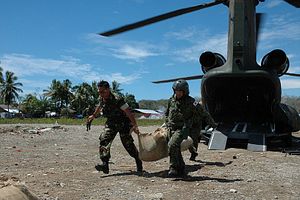The Yomiuri Shimbun’s English-language newspaper The Japan News reported on Monday that the Japanese government is considering the placement of Ground Self-Defense Force camps on three of the westernmost Nansei Islands, near the disputed Senkaku/Daioyu Islands. The camps would house teams of 350 members who would be deployed “to handle attacks on remote islands… [and] in the case of an imminent attack on a remote island, members of the envisaged team are to land on the island before the potential invaders and collect relevant information while preparing for deployment.”
The three camps will be based on the islands of Amami Oshima, Ishigakijima and Miyakojima. Ishigakijima and Miyakojima are especially close to the Senkaku/Diaoyu Islands, at 170 km and 210 km away, respectively. According to Japan News the government plans to deploy the teams by fiscal 2018 and task them with handling remote island attacks and natural disaster relief.
This comes exactly one month after Japan began construction of a military radar installation to be staffed by 150 personnel on the nearby island of Yonaguni, which is just 150km from the Senkaku/Diaoyu Islands. At the construction opening ceremony, the BBC reported that Japanese Defense Minister Itsunori Onodera “suggested his country’s military presence could be extended to other islands in the region.”
The South China Morning Post suggested that these deployments will serve to break up China’s “first island chain” between the Philippines northern islands and Japan’s southwestern islands, in addition to strengthening Japan’s claim to the disputed islands. The Japan Times quoted a senior Defense Ministry official as saying that, concerning the defense buildup of the Nansei Islands which are close to the “first island chain, [i]t is also aimed at strengthening the Japan-U.S. security system.”
The U.S. is indeed interested in seeing Japan increase its role in the defense alliance, despite President Barack Obama stating that the Senkaku/Diaoyus fall under the umbrella of the U.S.-Japan security treaty during his visit to Tokyo last month. The announcement of the new camps also came the day before the ruling LDP and its coalition partner New Komeito are due to begin discussions over Japan’s right to collective self-defense.
Equally interesting is that on May 17 China and Japan held their first cabinet-level meeting in China since Abe took office. Despite each side accusing the other of violations of sovereignty, both trade ministers stressed the importance of their economic relationship and their expectation that Japan and China will hold a sideline summit at the Beijing APEC conference in November, according to the Asahi Shimbun.
Japan may perhaps be seeking to solidify both its presence and its claim around the disputed islands before attempting to returning trade and investment with China to normal levels. What is more likely however, is that Abe is attempting to beef-up Japanese military commitments near its disputed territories before discussions over collective self-defense in order to frame the debate, and give the issue a greater sense of urgency.

































